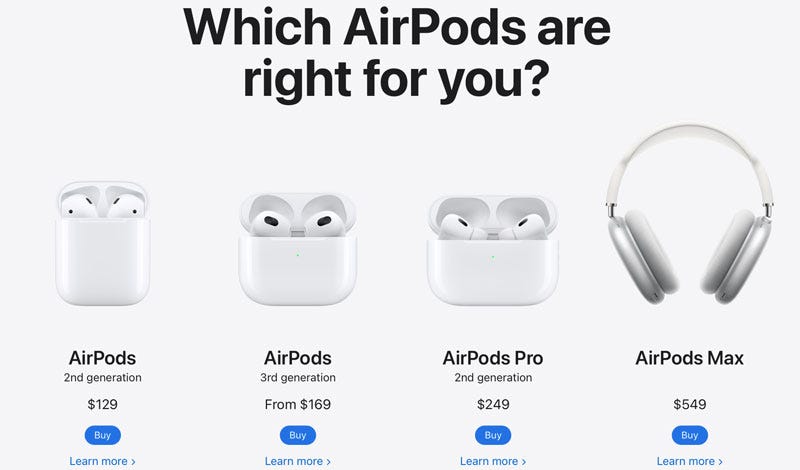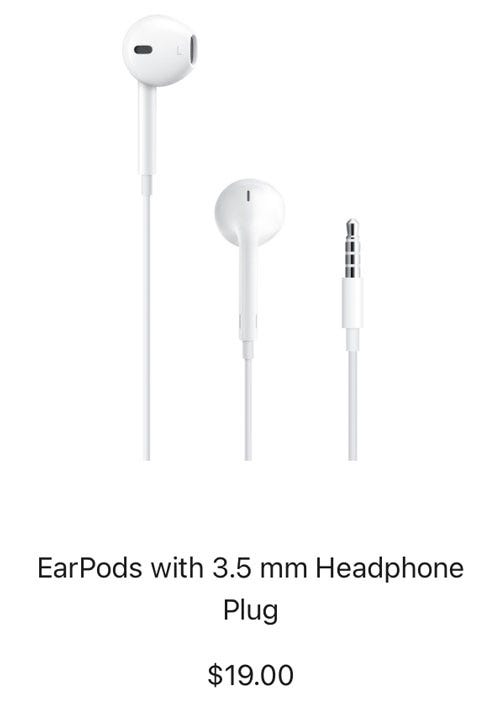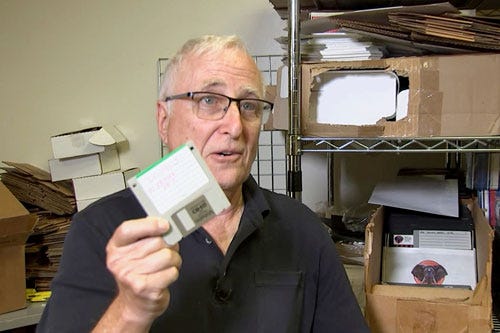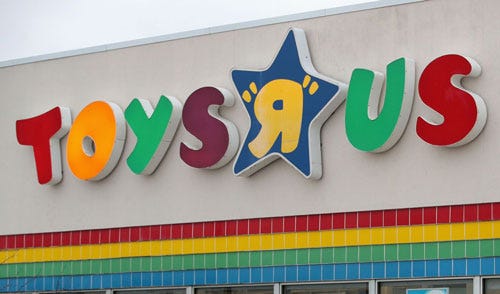Wednesday Walk: Legacy vs Landfill
My expensive headphones are disposable, animatronics powered by floppy disk, and appreciating the origins of our clothing
Welcome to Willoughby Hills!
As is typical every Wednesday, today I’m bring you a smattering of topics that I hope will make you a bit more curious about the world around you and give you something to think about later.
If you like what you’re reading, you can sign up to have this newsletter delivered to your inbox every Wednesday and Sunday for free:
Before we begin, I will be making some very exciting announcements about new things coming to Willoughby Hills this week.
I am not quite ready to share all the details with you, but look for a separate email from me in the next few days with all of the information!
Why Can’t This Last?
I’ve spent this week working in Boston, which means a hybrid commute. I drive from my exurban home for about 40 minutes and park at a train station at the edge of Cambridge, MA. From there, I take the subway the rest of the way into the city.
I started listening to a podcast in my car that was giving me a major “driveway moment” when I got to the train station parking garage (more on that below). I decided to pull out my Apple AirPods so that I could continue listening to the podcast on the subway.
After about 20 minutes, I heard a little beep in my left ear and suddenly the sound went away in that ear. The battery had died. I listened solely in my right ear for another 5 minutes or so until the right ear bud also died.
Now granted, my AirPods are about four years old at this point, but Apple still sells the version that I have and it advertises a 5 hour listening time when brand new. With 25 minutes of listening time, my AirPods appear to have lost about 92% of their capacity over the last four years.
I reluctantly began to investigate replacing my AirPods. Depending on my needs, that could cost me anywhere from $129 to $549!

Then I remembered there was another solution. I had another pair of headphones in my backpack that I nearly forgot were in there. It’s a pair of the hardwired earbuds that used to be included with every new iPhone purchase (but no longer are). They’d been stashed in my backpack for a while in case of an emergency.
This particular pair of headphones have a 3.5mm standard headphone plug on the end, which means they’re quite a bit older than my AirPods. Apple began to ship headphones with their proprietary lightning plug beginning with the iPhone 7 in 2016.
Should I need to replace those old headphones someday, Apple still sells them for only $19. There are even generic versions on Amazon for half that price.

I had forgotten the simplicity of basic earbuds like this, but the more I used them, the more I liked them. They require an adapter to work with newer iPhones, but they work with just about any other device I have without any additional hardware, including my laptop, iPad, podcast mixer, airplane TV sets, and even an original 1980s GameBoy that I have on my desk at home.
And by the way, that GameBoy, which I bought second hand in 1992 for my first cross-country plane trip, still works. Or at least it still turns on (I need to dig out an old cartridge to verify that it’s fully functional). It had been at my parents’ house for years gathering dust and I recently retrieved it. For a 30 year old piece of electronics, all it needs to keep running is a fresh pack of AA batteries.
Which brings me to my larger point in all of this. As we’ve built things to be “better” we’ve also built them to be more disposable. Tiny rechargeable batteries built into wireless earbuds are great, but when they die after a few years, the entire device is rendered useless.
I loved my AirPods when they worked, but the tradeoff of that joy is an endless cycle of consumption, replacing yet another device year after year.
For a few years, I was wearing an AppleWatch too, but after a while, I decided to switch back to my analog watch. I liked that the analog watch only needed a new battery every few years, whereas my AppleWatch needed to be charged every single night, often didn’t last all day, and required replacing every two years or so. (And that’s not even mentioning the distraction of constantly having your wrist vibrate with notifications).
Our society tells us that we should aspire for the latest and greatest at all times, but I’m starting to lean towards quality, durability, and simplicity over high tech but quickly obsolete.
Survival of the Floppies

Along those lines, I wanted to share a recent BuzzFeed News article that I came across by Katie Notopoulos titled “Chuck E. Cheese Still Uses Floppy Disks To Make Its Rodent Mascot Dance — For Now.”
The piece opens this way:
“Until 2019, believe it or not, the US nuclear weapons program ran on 8-inch floppy disks. As of today, there are still quite a few technologies that rely on floppies: Boeing 747 jets. Part of the San Francisco public transit system. And — on a slightly less concerning, but no less amusing note — the performing animatronic creatures at Chuck E. Cheese restaurants.”
Notopoulos was inspired to write this story after Chuck E. Cheese employee and TikTok user Stewart Coonrod (who uses the handle showbizpizzaman) posted a video showing how he uses 3.5” floppy disks to load the latest show information in the computer that controls the restaurant’s animatronic figures. Yes, a 3.5” floppy disk. In 2023.

Notopoulos was also able to locate Tom Persky, the vendor that provides the floppy disks to Chuck E. Cheese (his company, not surprisingly, is called floppydisks.com). Persky shares why some companies still rely on technology that most of us probably thought was left behind in the last century:
“If you’re looking for something very stable, really nonhackable — it's not internet-based, not network-based,” Persky said. “It's quite elegant for what it does.”
Persky was profiled by Phil Lavelle for Reuters in 2022, at which time he explained who his customer base was:
“Who buys floppy disks in an age when more sophisticated storage devices like CD-ROMS, DVDs and USB flash drives have been made increasingly obsolete by internet and cloud storage? Those in the embroidery, tool and die, and airline industry, especially those involved in aircraft maintenance, says Persky.”

When I worked at Toys R Us in the late 1990s and early 2000s, I was surprised that all of the in-store music and announcements were recorded on cassettes which were shipped to the stores from the corporate office every few weeks. This was in an era when CDs had surpassed cassettes by a long shot, but for some reason, it still made sense for Toys R Us to use tapes in store.
I stopped working at Toys R Us in 2005, but I remember seeing in-store cassettes from around 2008 or 2009 advertised for sale on eBay not long ago, meaning they were in use for several more years after I left. For all I know, they may have been in use until the end of the company in 2018. (The eBay listings have since ended and I can’t locate them now).
I’m not sure how much the use of these antiquated technologies like floppy disks or cassette tapes point to enlightened corporate overlords that are hyper-focused on reliability. I suspect it’s more likely momentum and an unwillingness to invest in updated infrastructure that gets us to this point.
Based on the BuzzFeed News story, it definitely seems like it may be the latter:
“Eventually, Chuck E. Cheese plans to phase out animatronics altogether and focus on new screen-based entertainment (plus an even more retro approach: a live human in a mascot costume). The overhaul was first announced in 2017, but the restaurant renovations are an ongoing process, and it may be a year or two before the last of the animatronics are done away with.”
Regardless of how we ended up at this point, it does seem like retro tech is having a comeback (or in the case of Chuck E. Cheese, perhaps it never left).
In that vein, the latest item on my thrift store shopping list is a nice clock radio after striking out when seeking a new one at big box stores. Lots of places sell digital alarm clocks, but finding one that also has a radio too is proving elusive. I don’t mind buying an old one from a thrift store, because, like the Chuck E. Cheese computer or my vintage Game Boy, those old clock radios are built solidly and may outlive me.
I often play the radio in the background while I cook or work, but it’s always through a smart speaker or a phone app these days. I miss listening over the air. My dad had an old clock radio in the garage that he used to play when he would do house projects on Saturdays and maybe I’m channeling a bit of him in this quest.
If I find a suitable clock radio, I may clean it up and use it as is, or I may look at salvaging the guts of it and putting it in a new case like I saw David Picciuto do on his YouTube channel a while back:
If I ever find the right one, I’m hoping the clock radio will live a long life on my nightstand and someday it will look as quaint but stubborn as those floppy disks.
#NoNewClothes- Week 21
It’s a bit hard to believe, but I’m coming up on half a year since I’ve bought a new article of clothing. For those of you who are new here, this was all inspired by a conversation I had a few months ago with Amory Sivertson, who undertook a similar journey last year.
In these Wednesday Walk columns, I have been occasionally sharing ideas with those of you who may be interested in buying less clothes and/or better clothes.
At the beginning of this newsletter today, I mentioned that I had been listening to a podcast on my drive that I couldn’t stop listening to and it caused me to switch over to my AirPods. That podcast was a recent episode of Mike Rowe’s podcast The Way I Heard It titled “The Incredible Symphony of Things.”
In this episode, Mike interviewed Bayard Winthrop, the founder and CEO of American Giant, which is an apparel company that makes its products exclusively in the USA.
To give you a sense of the values of American Giant, here’s an excerpt from their About Us page:
“Maybe, like us, you’ve looked around and not liked what you’ve seen. Mega-corporations, obsessed with handing profits over to shareholders, grow bigger and bigger, churning out cheap stuff that leaves us all feeling empty. Meanwhile, working people are left behind. Communities hollow out. And junkyards fill with all that stuff. Maybe, like us, you’ve wondered if there is a better way. If you can do something to make things better. And where you might start.”
Bayard and Mike had a wide ranging conversation about the challenges of setting up a supply chain and manufacturing infrastructure in the US at a time when most apparel production is done overseas.
Part of the problem as Bayard relayed in the podcast episode it is that too many of us are disconnected from each other and from the realities of what it means to live in this modern world:
“I think that we have, over the last 15 years or so- through technology, digital technology, through globalized supply chains- we have become increasingly disconnected from one another. We date online, we order food online, we order our sneakers online. Everything we’re doing is sort of, we’re Zooming all the time, we’re not together.”
Part of what set me on this journey to consuming less clothing and being conscious about that which I did buy was talking to journalist and author Amelia Pang about the harsh realities of forced labor in Chinese factories, often for major fashion brands.
Bayard had a similar awakening when he realized the complexity of our apparel supply chain and all of the people that work hard to turn the cotton that grows out of the ground into the shirt on our back:
“It wasn’t until I got into a car, and drove, I don’t know, 180 radial miles and saw in the course of two days: cotton coming out of the ground, getting ginned, getting baled, getting spun into yarn, knitted into cloth, dyed in dying facilities, finished in finishing facilities, and cut and sewn and out the other end came a sweatshirt. It was a totally humbling and a completely remarkable experience and it seems weird to say it, but it’s easy to forget that so much of the clothes that we wear started off as an agricultural crop and the incredible symphony of things that have to happen to produce a sweatshirt on the other end. When you are exposed to that, it is totally awe inspiring and the talent and skill required to do it, it is such a privilege to see that stuff.”

Like I said, the conversation was about apparel, but it was also about having an appreciation for where all things come from and the contributions that other humans have in our lives. It’s part of the reason that I am supportive of local farms. It may be more expensive, but there is something about the immediacy of knowing that a pig in the pen is also the bacon in the barn freezer that gives me much more appreciation of the process.
Bayard made this larger point when discussing why he likes Mike Rowe and Dirty Jobs:
“That understanding about how things get done, how things get made, how the food gets on your table, and the people that do that work, the miracle that that work is, and the honor that is owed to those men and women. Once you’re exposed to it, it’s really intuitive, it’s like ‘oh yeah, I get it.’ The more that it’s sort of in this blurry distance, the easier it becomes to not kind of look at it and confront it and address it.”
The full interview is really a worthwhile listen!
I can’t speak to American Giant’s quality or durability, but I like the simplicity of their styles and would definitely consider buying their products. I’ll just have to wait a few more months to make that purchase!
Thank you for reading! I always love hearing your thoughts, so please drop a line in the comments.
I publish new issues every Wednesday and Sunday. Sign up to always receive the latest issue and support my work:
Other Wednesday Walks
Please consider sharing this with a friend that you think might enjoy it or you can post it on social media.
If you’ve missed past issues of this newsletter, they are available to read here.
Stay Safe!
Heath







